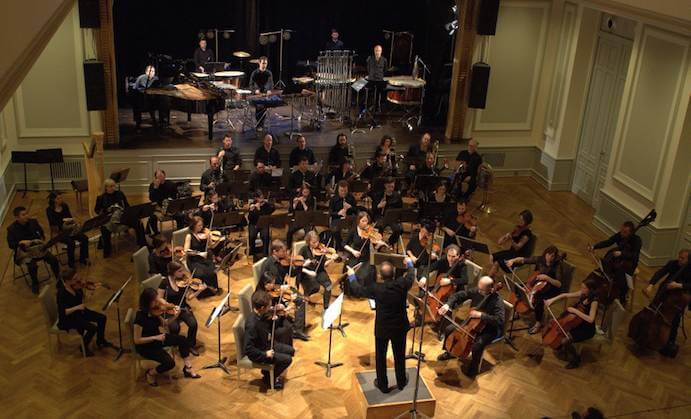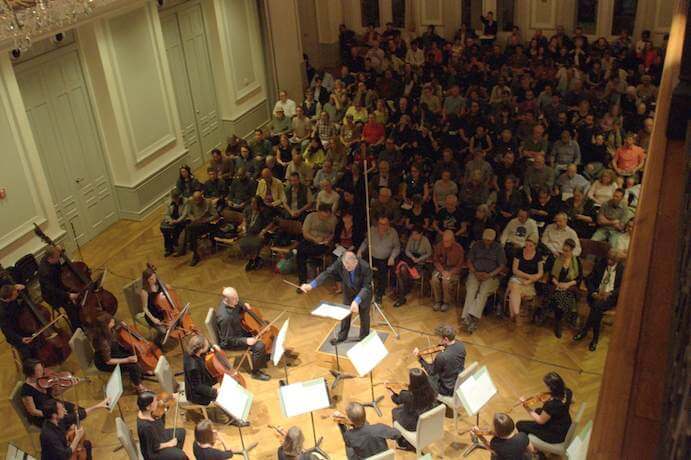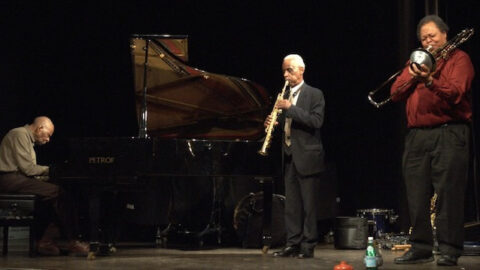The Association for the Advancement of Creative Musicians (AACM) has produced some of America’s best avant-garde music over the past half a century. Founded in 1965 on the south side of Chicago and expanding to New York in 1983, the experimental art collective changed the landscape of improvisational music by sponsoring innovative composition and sustaining rigorous conceptual discourse. In celebration of their 50th anniversary, the collective partnered with the S.E.M. Ensemble and the Interpretations Series to present two “AACM50” concerts.
Both concerts were hosted by the Bohemian National Hall, the elegant ballroom space of the Czech Center for New York complete with chandeliers, a wrap-around balcony, and reverberating acoustics. The second concert on April 29, 2015 featured the Orchestra of the S.E.M. Ensemble performing three original compositions by long-time AACM members. Friends and admirers packed the space to standing room only in unusually warm appreciation for the evening’s celebration, and the whiteness of the S.E.M. Ensemble was a stark contrast to the diversity of the audience. Little was said about the collective’s two chapters, which are markedly different in Chicago and New York; instead, the eclectic programming and veteran improvisation illustrated the AACM’s individual aesthetic and complex internal ideals. S.E.M. conductor Petr Kotik opened the program with a speech highlighting the showcase’s singular nature: “no other institution in the world would sponsor this event.”

The program’s first half showcased notated composition, and it opened with a wave of orchestral sound around the ballroom. George Lewis’ recent “MEMEX” took inspiration from a 1945 thought experiment to awaken a critically engaged audience. Although tempting for audiences to reflexively assume that notated compositions dominate their hearers, Lewis posited that every musical experience, regardless of form, requires equal agency of the listener. By utilizing form in an unexpectedly improvisational way, Lewis leveraged the element of surprise to confront listener expectations and transform their passivity into active navigation. Mimicking memory’s parallel volatility, “MEMEX” rotated sections of full strings in extended technique; a harp solo; a double bass solo; extended technique rearranged to include a harp solo; moments of limpid jazz piano; and solo chimes. The quick spins through timbre and technique without logical development were unsettling and eerie, but the effect did pique curiosity and the S.E.M. Orchestra assured the listener with its exacting precision and gleaming control.
The world premiere of Roscoe Mitchell’s “KINGMAKER” was an engaging experiment in absurdity. Mitchell constructed non-sentence vocal text to complement longtime collaborator Thomas Buckner’s improvisational technique, and halfway through the piece Buckner began to illustrate his distinctive baritone style. His face convulsed with each guttural consonant: “Reductio ad absurdum!” The compositional tension between form and freedom was rubbery as it alternated between full and partial notation; by the time Buckner sang five solos, struggling to be heard through thick strings, a four-person choir birthed full absurdity by accompanying the improvising soloists with nonsensical text as the stalwart orchestra played on. In his sparse contributions on saxophone, however, Mitchell slipped above these elements with ease, producing mercurial tones that slid in and out of his instrument’s full dynamic range in elegant control over the orchestra.
An electronic opening preceded co-founder Muhal Richard Abrams’ “Mergertone” orchestration, which notably explored each instrumental section before using the celli to focus the orchestra and drive it towards an integrated conclusion. Abrams’ expertise as a jazz pianist bled into the brief, clear piano highlights that contrasted extended sections of traditional string orchestration, and he received a warm standing ovation to close out the first half.

It was a great pleasure to hear the composers switch hats and take the stage for a relaxed and gradually cogent improvisation. Lewis on trombone peppered the thirty minutes with brief, percussive motifs, unperturbed by his colleagues’ more extreme contributions as he popped his mute in and out. Abrams’ long periods of silence provided understated leadership from the piano, and his prescient chords and quiet ripples supported the shiny torrent of Mitchell on the alto, soprano, and sopranino saxophone. Mitchell’s ascent on each instrument evolved into the highlight of the improvisation; standing with legs coolly crossed, he employed circular breathing techniques to unleash an assault of sopranino virtuosity that embodied the spirit of celebration.
Regardless of form, any listening is a volatile situation: listeners bring their intention, expectation, and hope to a situation that is indeterminate. Both the concert’s music and its programming startled these expectations and forced its audience to navigate the upset. The music subverted standard function; the featured composers were notably absent from speechmaking; no context was given for newcomers to the collective, and no future was envisioned for longtime admirers. Only once they had presented their current philosophical ruminations did the AACM composers relent and offer a brief nod to their legendary improvisational history. Abrams, Mitchell, and Lewis were not interested in justifying their collective’s celebrated worth, flaunting international acclaim, or forecasting glory. Instead, they allowed their current experimental daring and indifferent virtuosity to showcase the AACM’s singular explorations of the avant-garde frontier.
























